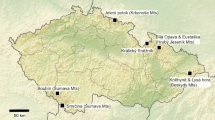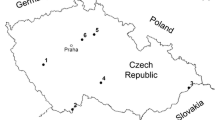Abstract
Chestnut forest ecosystems represent an important component of the European Mediterranean basin and the Southern Alps landscape. Despite the good knowledge acquired in the phytosanitary and cultural aspects of chestnut, there is still a lack of data on the relationships between chestnut and epiphytes. We have investigated the changes in frequency of occurrence and species composition of lichen assemblages against the main site characteristics and environmental variables in chestnut woods along a bioclimatic and geographical gradient in Central-North Italy.
The study has highlighted a geographic gradient from the Western Alps to the Northern Apennines. We recorded a total of 152 taxa, only 49 of which occurring in all the bioclimatic zones. The distribution of lichen communities in chestnut stands is mainly associated with increasing precipitation and decreasing temperature, thus confirming the prevailing influence of macroclimatic factors on epiphytic lichens. The species composition statistically differs also in stands differently managed (orchards vs. coppices).
Chestnut woods host interesting communities, with rare species related to Lobarion, and can represent a good habitat for threatened epiphytic species.
Similar content being viewed by others
References
Amorini E., Chatziphilippidis G., Ciancio O., Di Castri F., Giudici F., Leonardi S., Manetti M.C., Nocentin S., Pividor M., Rapp M., Romane F., Sevrin E. & Zingg A. 2000. Sustainability of chestnut forest ecosystems: is it possible? Ecol. Mediterr. 26: 3–14.
Asta J., Erhardt W., Ferretti M., Fornasier F., Kirschbaum U., Nimis P.L., Purvis O.W., Pirintsos S., Scheidegger C., Van Haluwyn C. & Wirth V. 2002. Mapping lichen diversity as an indicator of environmental quality, pp. 273–279. In: Nimis P.L., Scheidegger C. & Wolseley P. (eds), Monitoring with lichens — Monitoring lichens, Kluwer, Dordrecht.
Aude E. & Poulsen R.S. 2000. Influence of management on the species composition of epiphytic cryptogams in Danish Fagus forests. Appl. Veget. Sci. 3: 81–88.
Barkman J.J. 1958. Phytosociology and ecology of cryptogamic epiphytes. Van Gorcum and Comp., Assen, 628 pp.
Barluzzi C., Perini C. & De Dominicis V. 1992. Coenological research on macrofungi in chestnut coppices of Tuscany. Phytocoenologia 20: 449–465.
Benesperi R. & Fappiano A. 2005. Influenza della gestione forestale sulla distribuzione di Lobaria pulmonaria (L.) Hoffm. nell’Appennino settentrionale e Alpi Apuane (Toscana, Italia Centrale). Inform. Bot. Ital. 37: 392–393.
Bergamini A., Stofer S., Bollinger J. & Scheidegger C. 2007. Evaluating macrolichens and environmental variables as predictors of the diversity of epiphytic microlichens. Lichenologist 39: 475–489.
Boudreault C., Gauthier S., Drapeau P. & Bergeron Y. 2002. Bryophyte and lichen communities in mature to old-growth stands in eastern boreal forests of Canada. Can. J. Forest Res. 32: 1080–1093.
Bounous G. 2002. Il castagno. Coltura, ambiente ed utilizzazioni in Italia e nel mondo. Bologna: Edagricole, 311 pp.
Bounous G. & Beccaro G.L. 2010. Proceedings of the first European Congress on Chestnut Castanea 2009. Acta Horticulturae 1: 1–726.
Castello M. & Skert N. 2005. Evaluation of lichen diversity as an indicator of environmental quality in the North Adriatic submediterranean region. Science of the Total Environment 336(1–3): 201–214.
Conedera M., Manetti M.C., Giudici F. & Amorini E. 2004. Distribution and economic potential of the sweet chestnut (Castanea sativa Mill.) in Europe. Ecol. Mediterr. 30: 179–193.
Coxson D.S. & Stevenson S.K. 2007. Influence of high-contrast and low-contrast forest edges on growth rates of Lobaria pulmonaria in the inland rainforest, British Columbia. Forest Ecol. Manag. 253(1–3): 103–111.
Diamandis S. & Perlerou C. 2001. The mycoflora of the chestnut ecosystems in Greece. For. Snow Landsc. Res. 76: 499–504.
Ellis C.J. & Coppins B.J. 2006. Contrasting functional traits maintain lichen epiphyte diversity in response to climate and autogenic succession. J. Biogeography 33: 1643–1656.
Ellis C.J. & Coppins B.J. 2007. Changing climate and historicwoodland structure interact to control species diversity of the ‘Lobarion’ epiphyte community in Scotland. J. Veget. Sci. 18(5): 725–734.
Ellis C.J. & Coppins B.J. 2009. Quantifying the role of multiple landscape-scale drivers controlling epiphyte composition and richness in a conservation priority habitat (juniper scrub). Biol Conservation 142: 1291–1301.
Ellis C.J. & Coppins B.J. 2010. Integrating multiple landscapescale drivers in the lichen epiphyte response: climatic setting, pollution regime and woodland spatial-temporal structure. Diversity and Distributions 16: 43–52.
Esseen P.A., Ehnstrom B., Ericson L. & Sjoberg K. 1992. Boreal forests — the focal habitats of Fennoscandia, pp. 252–325. In: Hansson L. (ed.), Ecological Principles of Nature Conservation. Applications in Temperate and Boreal Environments, Elsevier Applied Science, London.
Esseen P.A., Renhorn K.E. & Pettersson R.B. 1996. Epiphytic lichen biomass in managed and old-growth boreal forests: effect of branch quality. Ecological Applications 6: 228–238.
Friedel A., Oheimb G.V., Dengler J. & Hardtle W. 2006. Species diversity and species composition of epiphytic bryophytes and lichens — a comparison of managed and unmanaged beech forests in NE Germany. Feddes Repert. 117: 172–185.
Fritz O., Gustafsson L. & Krister Larsson K. 2008. Does forest continuity matter in conservation? — A study of epiphytic lichens and bryophytes in beech forests of southern Sweden. Biol. Conserv. 141: 655–668.
Giordani P. 2006. Variables influencing the distribution of epiphytic lichens in heterogeneous areas: A case study for Liguria, NW Italy. Journal of Vegetation Science 17: 195–206.
Giordani P. 2007. Is the diversity of epiphytic lichens a reliable indicator of air pollution? A case study from Italy. Environ. Poll. 146: 317–323.
Giordani P. & Incerti G. 2008. The influence of climate on the distribution of lichens: a case study in a borderline area (Liguria, NW Italy). Plant Ecology 195: 257–272.
Gondard H. & Romane F. 2005. Long-term evolution of understorey plant species composition after logging in chestnut coppice stands (Cevennes Mountains, Southern France). Ann. Forest Sci. 62: 333–342.
Gondard H., Romane F., Santa Regina I. & Leonardi S. 2006. Forest management and plant species diversity in chestnut stands of three Mediterranean areas. Biodivers. Conservat. 15: 1129–1142.
Hilmo O. & Såstad S.M. 2001. Colonization of old-forest lichens in a young and an old boreal Picea abies forest: an experimental approach. Biol. Conservation 102: 251–259.
Humphrey J.W., Davey S., Peace A.J., Ferris R. & Harding K. 2002. Lichens and bryophyte communities of planted and semi-natural forests in Britain: the influence of site type, stand structure and deawood. Biol. Conservation 107: 165–180.
Kruskal J.B. 1964. Nonmetric multidimensional scaling: a numerical method. Psychometrika 29: 115–129.
Leonardi S., Rapp M. & Romane F. 2000. Sustainability of chestnut forest ecosystems: is it possible? International Symposium organised by the Università degli Studi di Catania; 1998 Sep 18-23; Catania. Ecol. Mediterr. 26: 1–179.
Lesica P., McCune B., Cooper S.V. & Hong W.S. 1991. Differences in lichen and bryophyte communities between oldgrowth and managed second-growth forests in the Swan Valley, Montana. Can. J. Bot. 69: 1745–1755.
Lindacher R. & Pietschmann M. 1990. Altersstadien moosreicher Vegetation auf Castanea sativa in Elba. Herzogia 8: 383–401.
Loppi S. & Nascimbene J. 1997. Lichen bioindication of air quality in the Mt. Amiata geothermal area (Central Italy). Geothermics 27: 295–304.
Loppi S., Putortì E. & De Dominicis V. 1997. Florula lichenica epifita di un castagneto (Montieri, Toscana). Atti del Museo di Storia Naturale della Maremma 16: 85–90.
Lukošiene I.P. & Naujalis J.R. 2009. Rare lichen associations on common oak (Quercus robur) in Lithuania. Biologia 64: 48–52.
Manetti M.C., Amorini E. & Becagli C. 2006. New silvicultural models to improve functionality of chestnut stands. Adv. Hort. Sci. 20: 65–69.
McCune B. & Mefford M.J. 1999. Multivariate analysis of ecological data. Version 4.25. MjM Software, Gleneden Beach, OR, US.
Mežaka A., Brumelis G. & Piterans A. 2008. The distribution of epiphytic bryophyte and lichen species in relation to phorophyte characters in Latvian natural old-growth broad leaved forests. Folia Cryptog. Estonica 44: 89–99.
Ministero dell’Ambiente e Tutela del Territorio, Politecnico di Torino. 2005. GIS Natura, il GIS delle conoscenze naturalistiche in Italia.
Moning C., Werth S., Dziock F., Bässler C., Bradtka J., Hothorn T. & Müller J. 2009. Lichen diversity in temperate montane forests is influenced by forest structure more than climate. Forest Ecol. Manage. 258: 745–751.
Nascimbene J., Isocrono D., Marini L., Caniglia G. & Piervittori R. 2006. Epiphytic lichen vegetation on Larix in the Italian Alps. Plant Biosystems 140: 132–137.
Nascimbene J., Brunialti G., Ravera S., Frati L. & Caniglia G. 2010. Testing Lobaria pulmonaria (L.) Hoffm. as an indicator of lichen conservation importance of Italian forests. Ecological Indicators 10: 353–360.
Nimis P.L. & Martellos S. 2008. ITALIC — The Information System on Italian Lichens. Version 4.0. University of Trieste, Dept. of Biology, IN4.0/.1. Available from: http://dbiodbs.univ.trieste.it/.
Öckinger E., Niklasson M. & Nilsson S. 2005. Is local distribution of the epiphytic lichen Lobaria pulmonaria limited by dispersal capacity or habitat quality? Biodivers. Conserv. 14: 759–773.
Ohlson M., Söderström L., Hörnberg G., Zakckrisson O. & Hermansson J. 1997. Habitat qualities versus long-term continuity as determinants of biodiversity in boreal old-growth swamp forests. Biol. Conserv. 81: 221–231.
Perhans K., Gustafsson L., Jonsson F., Nordin U. & Weibull H. 2007. Bryophytes and lichens in different types of forest setasides in boreal Sweden. Forest Ecol. Manage. 242: 374–390.
Privitera M. & Puglisi M. 2000. The ecology of bryophytes in the chestnut forests of mount Etna (Sicily, Italy). Ecol. Mediterr. 26: 43–52.
Privitera M., Puglisi M., Cenci R.M. & Beone G.M. 2006. Bryophytes biodiversity for monitoring chestnut ecosystem on Mount Etna (Estern Sicily). Adv. Hort. Sci. 20: 28–32.
Pykala J. 2004. Effects of new forestry practices on rare epiphytic macrolichens. Conservation Biol. 18: 831–838.
Radies D.N. & Coxon D.S. 2004. Macrolichen colonization on 120-140 year old Tsuga heterophylla in wet temperate rainforests of central-interior British Columbia: a comparison of lichen response to even-aged versus old-growth stand structures. Lichenologist 36: 235–247.
Re G.F. 1824. Flora pedemontana. Appendix altera. Tip. Regia Taurini.
Rose F. 1976. Lichenological indicators of age and environment continuity in woodlands, pp. 279–307. In: Brown D.H., Hawksworth D.L. & Bailey R.H. (eds), Lichenology: Progress and Problems Academic Press, London.
Roth I. & Scheidegger C. 1997. Die Edelkastanie als Lebensraum für epiphytische Flechten. Bünderwald 3: 59–68.
Scheidegger C. & Clerc P. 2002. Lista Rossa delle specie minacciate in Svizzera: licheni epifiti e terricoli. Ed. Ufficio Federale dell’Ambiente, Foreste e Paesaggio UFAFP, Berna, Istituto federale di ricerca WSL, Birmensdorf, Conservatoire et Jardin botaniques de la Ville de Genčve CJBG L’ambiente in pratica, UFAFP Serie.
Sillett S.C. & Goslin M.N. 1999. Distribution of epiphytic macrolichens in relation to remnant trees in a multiple-age Douglas-fir forest. Can. J. For. Res. 29: 1204–1215.
Sillett S.C., McCune B., Peck J.E., Rambo T.R. & Ruchty A. 2000. Dispersal limitations of epiphytic lichens result in species dependent on old-growth forests. Ecol. Appl. 10: 789–799.
Svoboda D., Peksa O. & Vesela J. 2010. Epiphytic lichen diversity in central European oak forests: assessment of the effects of natural environmental factors and human influences. Env. Poll. 158: 812–819.
Svoboda D., Peksa O. & Veselá J. 2011. The analysis of epiphytic lichen composition in Central European oak forests. Preslia 83: 129–144.
Tretiach M. & Ganis P. 1999. Hydrogen sulphide and epiphytic lichen vegetation: a case study on Mt. Amiata (Central Italy). Lichenologist 31: 163–181.
Venturella G., Saita A. & Pecorella E. 2006. Fungal biodiversity in chesnut woods of Sicily (Southern Italy). Adv. Hort. Sci. 20: 28–23.
Author information
Authors and Affiliations
Corresponding author
Rights and permissions
About this article
Cite this article
Matteucci, E., Benesperi, R., Giordani, P. et al. Epiphytic lichen communities in chestnut stands in Central-North Italy. Biologia 67, 61–70 (2012). https://doi.org/10.2478/s11756-011-0145-8
Received:
Accepted:
Published:
Issue Date:
DOI: https://doi.org/10.2478/s11756-011-0145-8




